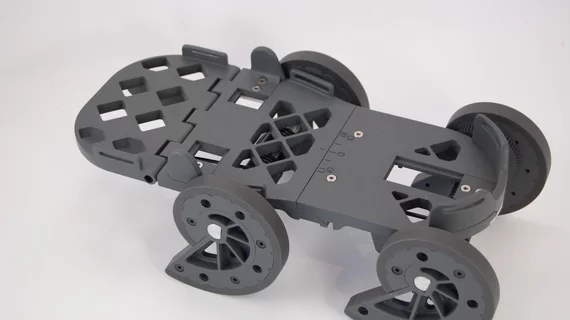Therapeutic shoe improves stroke survivors’ gait, symmetry
A therapeutic shoe designed to improve stroke survivors’ gait and symmetry was successful in a small-scale trial of six patients, according to a study published in the Journal of NeuroEngineering and Rehabilitation.
Developer Kyle Reed, PhD, said in a statement that since people who suffer strokes typically experience muscle weakness or partial paralysis on one side of their body, their balance is considerably impaired, causing them to walk with an asymmetrical gait. That kind of imbalance increases a person’s odds of falling and injuring themselves, and greatly limits their movement.
Reed compared his innovation—the iStride—to a previous study, which tested the efficacy of split-belt treadmill training on improving stroke patients’ gait. The approach improved stroke survivors’ abilities, but only 60% of study participants actually corrected their gait when walking in a normal environment and split-belt training fails to strengthen limb support.
The iStride was developed as a tool that could be used both in rehab and out, Reed said. It’s a portable device that’s strapped over the shoe of a patient’s “good leg” and generates a backward motion, exaggerating the step and making it harder to walk while wearing the shoe. The movement is awkward, but it strengthens the leg most impacted by a patient’s stroke, allowing for a smoother and more even gait when the iStride is removed.
“The backward motion of the shoe is generated passively by redirecting the wearer’s downward force during stance phase,” Reed said. “Since the motion is generated by the wearer’s force, the person is in control, which allows easier adaptation to the motion. Unlike many of the existing gait rehabilitation devices, this device is passive, portable, wearable and does not require any external energy.”
In his study of six patients aged between 57 and 74, all of whom had suffered a cerebral stroke within the past year and had asymmetry severe enough to impact their walking ability, Reed and his colleagues tracked the iStride’s success. Each patient received a dozen 30-minute gait training sessions with the shoe for four weeks, and their progress was measured using the ProtoKinetics Zeno Walkway system.
Reed reported that all participants improved the symmetry and speed of their gait, and four improved the percentage of time spent in a gait cycle with both feet simultaneously planted on the ground. The remaining two patients didn’t improve as much, but Reed noted one had severe impairment at baseline and the other was already highly functional.
Two of three subjects who were limited to movement within their homes at the start of the study were also able to progress to the point of navigating public venues.
Reed is now reportedly working on another home-based, 21-patient trial and is slated to publish his results next year.

